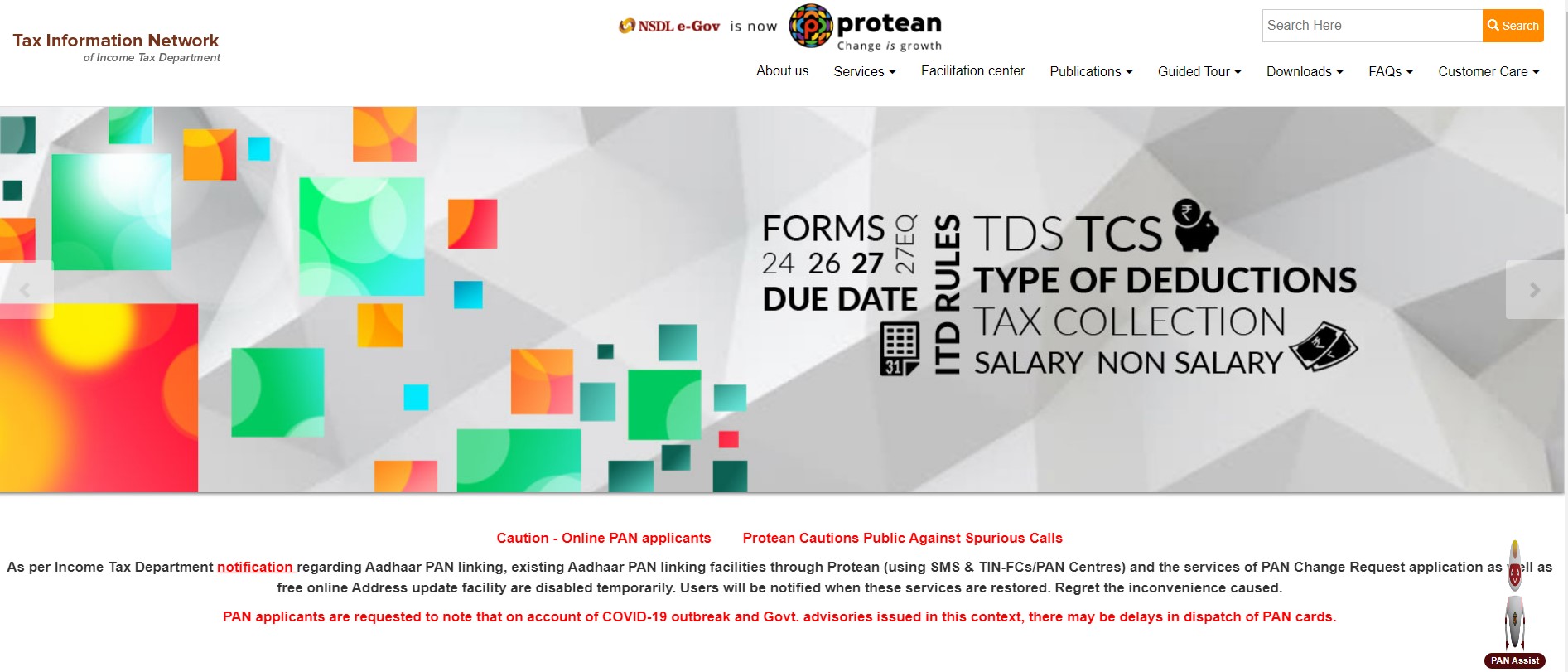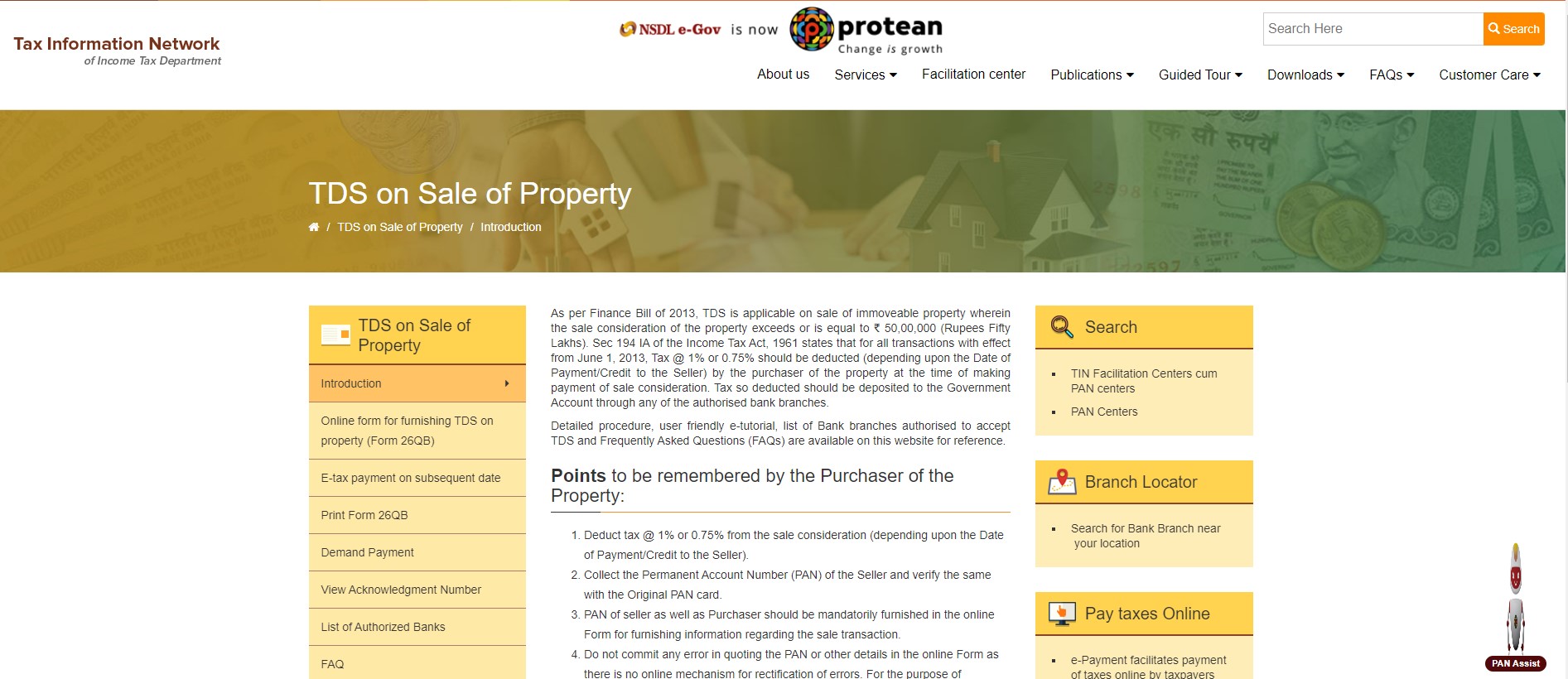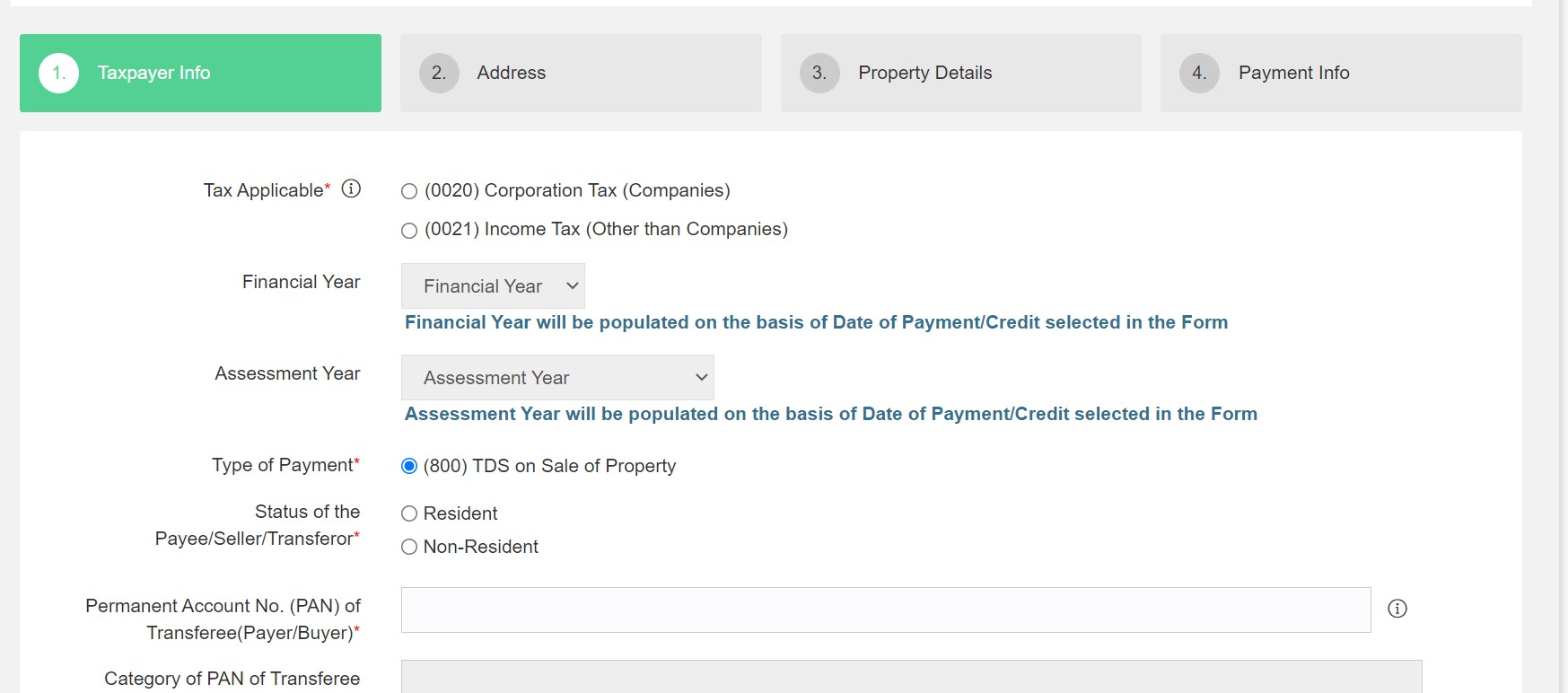How To File TDS on Sale of Property: Registration, Payment Process And Penalty

TDS on sale of property means Tax Deducted at Source (TDS) on the sale of immovable property, including a building, flat or vacant plot. Under Section 194IA of the Income Tax Act, 1% TDS on your transaction cost is applicable if the property value exceeds the limit of Rs. 50 lakh. Buyers must ensure tax is deducted and deposited to the government; after the deduction and deposition, they will have to provide the TDS certificate to the seller.
This post helps you understand TDS on sale of property – requirements, how to file a TDS on property sale, registration and payment process, how to fill Form 26QB, TDS on sale of property by NRIs and the penalty for non-payment of TDS on sale of the property. Read on!
Section 194IA: What is TDS on Sale of Property?
As per current guidelines, there is no instruction on how to calculate TDS if there is a difference between the actual sale value and the stamp duty value of the property. To abolish this inconsistency, the current Finance Minister Nirmala Sitharaman proposed to deduct 1% TDS on the sale of a non-agricultural immovable property on either its stamp duty value or its sale price, whichever is higher. This amendment is applicable from April 1, 2022. However, this also means that no deductions shall be made if the property value is less than Rs. 50 lakh.
Additionally, buyers can choose to make payments in instalments. For immovable properties bought on or after September 2019, sale amount must encompass club membership fees, electricity charges, maintenance fees and more. TDS on sale of immovable property is based on the sale amount stated in sale deed and is dependent on the capital gains.
Note, TDS is applicable to Indian residents only. If an assessee is a non-resident, then their applicable rate of deduction changes. A non-resident must pay a TDS of 20% + surcharge + cess. Also, TDS is applicable even if their property value is less than Rs. 50 lakh.
Also Read
Rate of TDS on Sale of Property
The prevailing TDS rate on sale of property is 1% to 0.75%, as set by section 194IA of the Income Tax Act. As per Budget 2022, property buyers must deduct 1% TDS on the overall sale value of the property.
Rate of TDS on Sale of Property Requirements Under Section 194IA
The following are the requirements of Section 194IA:
- TDS is something that buyers have to deduct rather than the seller.
- If buyers choose to settle their payment in instalments, then they should make their deduction in instalments with each payment.
- When calculating the total consideration of the property, all expenses, including car parking fee, club membership fee, maintenance fee, electricity or water facility fee, the advance fee shall be accounted for. This is for immovable properties acquired on or after September 1, 2019.
- TDS on the sale of immovable property is applicable on the entire sale value.
- TAN is not mandatory for paying the TDS amount. One can make TDS payment with PAN.
- Having PAN of the seller is compulsory; otherwise, the applicable TDS rate stands at 20%.
- A buyer must deduct TDS at the time of payment or when crediting the amount to the seller’s account, whichever takes place earlier.
- The payment of TDS shall be made using Form 26QB only. Also, this process should get completed within 30 days of deducting TDS.
- A buyer must present a TDS certificate in Form 16B to its seller. This form is available after 10 to 15 days from the date of TDS payment.
How to File TDS on Sale of a Property?
Here’s a step-by-step guide on how to pay TDS through Challan 26QB:
Payment through Challan 26QB
Follow these steps to make TDS payment via Challan 26QB:
- Visit the official portal of the Tax Information Network
Click on Tax Information Network of the Income Tax Department. Under the ‘Services’ tab, select the ‘TDS on Sale of Property’ option.

- Click on Form 26QB
You will be redirected to a new window. Click on ‘Online form for furnishing TDS on property (Form 26QB)’.

- Enter the Details
Enter the PAN of the seller and buyer, whether you are a resident or a non-resident, the transferor and transferee’s full address, property address, etc. Also, fill in the amount paid (in words & figures) and the deposited tax amount.

- Complete Payment
After you successfully provide all the information, proceed to the last tab, i.e., payment info. There are two forms of payments — either you can choose to pay immediately or pay at a subsequent date. After making a choice, click on the ‘proceed’ tab.
- Print Challan 280
You can pay using the net banking option. However, first, you will have to log in. Then, after making the payment, the site will allow you to print Challan 280.
If you don’t want to make an online payment, generate Form 26QB online using the unique Acknowledgement Number. Remember, it has a validation of 10 days, so take it to the bank for making payment before that.
Also Read
How to Register on TRACES
Step 1: If you are a first-time payer, you need to register in Traces using your PAN and challan number.
Step 2: After registering, you can get hold of your TDS certificate or Form 16B and issue it to the seller.
Step 3: You can also check your payment status, like details of ‘TDS on sale of immovable property u/s 194 IA’ after seven days.
Step 4: You can also find details of the deductee’s PAN, name, acknowledgment number, date, transaction amount, Form 16B number, and other information in PART F.
Also, know about how to obtain Form 16B for sellers in the below details:
How to Obtain Form 16B
Step 1: After making your payment, click on the Form 16B tab by logging in to your TRACES account.
Step 2: Enter the seller’s PAN details and acknowledgment number to complete the process and click on ‘proceed.’
Step 3: After double-checking every detail, select the ‘submit a request’ option.
Step 4: It will take a few hours to approve your request. Next, click on the ‘request download’ option available in the drop-down list.
Step 5: The status will change to ‘available’ or ‘submitted.’ If it is the latter, wait for a few more hours and reapply for the process.
Step 6: Lastly, download the zip file by entering your password (your date of birth).
How to Pay TDS on Sale of Property Online?
Here are the steps that will help you to pay TDS on sale of property online:
Step 1: Go to the official website of NSDL.
Step 2: Choose ‘Services’ and click on ‘e-payment-Pay taxes online’
Step 3: On getting redirected to a page showing different challans, click on ‘Proceed’ tab.
Step 4: Corporate payer must select the code 0020 and the non-corporate payer must choose 0021. On providing the code, details like financial year, payment mode, and assessment year will be automatically displayed on the screen.
Step 5: You are required to provide other details like seller’s and buyer’s PAN, transferee’s full residential address, property’s complete address, amount paid and more.
Step 6: You will come across the ‘Payment info’ tab on providing relevant information. Now choose your preferred mode of payment and select ‘Proceed’.
You will get an online receipt with an acknowledgement number for Form 26QB. This receipt is valid for 10 days. You will have to carry this receipt in any bank to proceed with the online payment.
Also Read
TDS on Sale of Property by NRIs
TDS provision is different for properties that are brought from NRIs. Here are some of the provisions for those buying properties from NRIs:
- Regular TDS rate: TDS rate for long term assets is 20%.
| For income below Rs. 50 lakhs | Income ranging between Rs.50 lakh- 1 crore | Income for more than Rs. 1 crore | |
| LTCG tax | 20% | 20% | 20% |
| Surcharges | 0 | 10% over the above rate | 15% over the above rate |
| Total tax + Surcharge | 20% | 22% (20% + 2%) | 23% (20% + 3%) |
| Health and education cess | 4% | 4% | 4% |
| TDS Rates to be applicable | 20.80% | 22.88% | 23.92% |
- Lower TDS Rates
Here are the ways that will help NRI sellers reduce the TDS rates:
- First, the seller should approach the Income Tax Officer of the jurisdiction to apply for a tax deduction.
- On applying for it, the assessing officer furnishes a lower TDS deduction certificate that contains computed capital gains amount on the specific asset.
- The buyers will be referring to this certificate to deduct TDS on the basis of the calculated capital gains in place of the asset value.
3. Changes in the sum on which buyers makes a tax deduction
The sum on which tax deduction takes place for the NRI seller will depend on whether he or she has opted for lower TDS deduction certificate or not. A lower tax deduction implies higher balance for the seller.
In case the NRI doesn’t get a TDS deduction certificate, TDS deduction will happen based on the total sale value of a property. Tax experts often advise NRI property sellers to obtain the certificates to reduce their tax liabilities.
4. Time of deduction
The deduction time is chosen depending on which one is the earliest (either during income credit or during payment).
5. TDS return and payment
As a buyer, you need to deposit the challan for TDS deduction within seven days from the end of the month in which the TDS deduction took place. However, you have to provide TDS return through Form 27Q.
Things to Consider for TDS on Sale of Property by NRIs
- Buyers must have a Tax Deduction and Collection Number (TAN) for purchasing a property from an NRI.
- The exemptions under Section 54A and 54C prove beneficial for the NRI seller.
- Non-resident Indians opting to sell property should provide Form 15CA and Form 15CB to the financial institution sending the money out of India. They can download these forms and submit to the banks.
TDS on Sale of Property for Joint Sellers
In case of joint sellers, both have to pay TDS in accordance with the considered sale value or the capital gains.
TDS on Sale of Property in case of Joint Owners
TDS on sale of property in case of joint sellers, essential property documents reflecting property co-ownership must be provided to the Department of Income Tax. The documents shouldn’t have a mere agreement showing the co-ownership. Rather, there should be details about each owner’s contribution.
A TDS rate of 1% is applicable if each owner’s sale consideration is above Rs.50 lakhs.
Also Read
Consequences of Late/Non-Filing of TDS Statement
There are implications for both sellers and buyers in case of late or non-filing of TDS:
Consequences for Buyers
- If a default has been made due to late or non-filing, buyers may have to pay a fee under Section 234EA of the Income Tax Act.
- Apart from the above, he/she may also be liable for late payment defaults, late deductions, and interests. There is a Section 271H that covers penalties in case of such situations.
- A buyer will also have to pay an amount of Rs. 200 each day until the failure continues.
Implications for Sellers
- The option of claiming TDS credit disappears for sellers in case of late or non-filing.
- Sellers must deposit TDS on sale of immovable property to the government either through net banking or by visiting their nearest bank. Also, they must remember to submit the deducted amount within seven days of the payment.
TDS on Sale of Property Payment Due Dates
You will get a well-rounded idea regarding TDS payment due date for FY 2022-2023 from the table given below:
Quarter Ending – June 30, 2022
| Deduction Month | Due date for TDS Payment |
| April 2022 | May 7, 2022 |
| May 2022 | June 7, 2022 |
| June 2022 | July 7, 2022 |
Quarter Ending – September 30, 2022
| Deduction Month | Due date for TDS Payment |
| July 2022 | August 7, 2022 |
| August 2022 | September 7, 2022 |
| September 2022 | October 7, 2022 |
Quarter Ending – December 31, 2022
| Deduction Month | Due date for TDS Payment |
| October 2022 | November 7, 2022 |
| November 2022 | December 7, 2022 |
| December 2022 | January 7, 2023 |
Quarter Ending – March 31, 2023
| Deduction Month | Due date for TDS Payment |
| January 2023 | February 7, 2023 |
| February 2023 | March 7, 2023 |
| March 2023 | April 7, 2023 ( when tax is deducted by government office) April 30, 2023 (by other deductors) |
Penalty for Late/Non-Filing of TDS on Sale of Property?
Here are the pointers that will acquaint you with the penalty provision in case of late payment of TDS:
- Under Section 271H, penalty charges can go up to Rs.1 lakh for not paying TDS on time.
- If the tax amount is not deducted on time, you will be charged interest of 1% every month as per section 201(1A) (i).
- You will have to pay a 1.5% interest amount each month for cases where tax is deducted but is not deposited with the government.
- Under section 234E, late filing fee is Rs 200 each day till the day of TDS return file.
The only way you can dodge such penalties is to keep track and make TDS collection and submission on time.
Also Read
Important Points to Remember
There are some points to remember about TDS for avoiding complications:
For buyers
- Depending on the date of payment, your deduction rate will vary.
- PAN is required to pay TDS on the purchase of a property.
- For carrying out any rectification, you must visit the Income Tax Department.
- There is no rectification process in case wrong PAN details have been provided.
- Make sure to double-check your seller’s PAN with the original one.
For sellers
- Sellers must provide their PAN to buyers.
- Verification in Form 26AS is necessary for confirming deductions made by your buyer.
Final Word
To find details regarding TDS applicable for the sale of property, read the above information carefully. It is a tax deducted at source by buyers on the transaction value. There are many conditions to keep in mind in case of late or non-filing. So, check them to avoid any confusion.
FAQs
Ans: Yes, after buyers deposit the TDS amount to the government, sellers can claim TDS credit against that particular transaction. Note that they can either claim credit or a TDS refund with the Government of India.
Ans: No, a seller cannot deposit TDS with the government on the buyer’s behalf. It is the sole responsibility of a buyer to submit it when buying a property. That said, sometimes banks can help by deducting the amount from disbursement and depositing it on the buyer’s behalf.
Ans: Seller’s PAN number is compulsory for TDS deduction and also for filing for Form 26QB. Before initiating the TDS deduction on a property sale, a buyer must get the PAN of the seller.
Ans: If a seller is an NRI, they can get their balance amount after deduction at the time of sale of property directly from the buyer. But one must make sure that the percentage deducted as TDS on sale of a property is 20% of the transaction value.
Ans: In case an individual has made the registration and settlement of a property before May 2013, there is no compulsion to file Form 26QB. However, this is a compulsory process to follow after June 1 2013.
Ans: The buyer is responsible for deducting TDS on sale of a property. Buyers can pay the TDS amount deducted using online mode or through a bank branch. Furthermore, he or she is required to keep the TDS payment receipt which can be used later for obtaining Form 26QB.
Ans: You can get a refund for TDS on property sale. While selling the property, buyers make a TDS deduction on the property and deposit that with the government, whereas, property sellers can get the same amount as refund by filing a TDS return.
Ans: Only property sellers can claim for TDS return on sale of property. Buyers or deductor cannot claim for the refund. The seller will be able to claim the TDS refund while filing for his/her income tax.
Ans: Each buyer will have to fill out Form 26QB challan separately. For example, if there are two property sellers and one buyer, and then total of two forms will be filled in. For two buyers and two sellers, there have to be four forms.
Disclaimer
This article is solely for educational purposes. Navi doesn't take any responsibility for the information or claims made in the blog.
Read More on Income Tax Act

Customer’s Feedback
No comments found.What is Form 26QB for TDS? How to Download and Submit it?
While purchasing a property, buyers are liable to pay various taxes. The Finance Act, 2013 made TDS... Read More »PF Withdrawal Rules 2023 – Rules, Documents Required and Types
EPF/PF Withdrawal Employees’ Provident Fund (abbreviated as EPF) is a popular retirement sav... Read More »Stamp Duty and Property Registration Charges in Delhi 2023
It is compulsory for property buyers in the Capital to pay stamp duty in Delhi during property regi... Read More »Income Tax Return – Documents, Forms and How to File ITR Online AY 2023-24
In India, it is mandatory for all taxpayers who earn more than the basic tax exemption limit to fil... Read More »What is Section 80CCD – Deductions for National Pension Scheme and Atal Pension Yojana
The Income Tax Act provides a number of deductions and tax benefits to taxpayers, so they can strat... Read More »Tax on Dividend Income: Sources, Tax Rate and TDS on dividend income
What are Dividends? Companies may raise funds for running their operations by selling equity. Th... Read More »Section 112A of Income Tax Act: Taxation on Long-Term Capital Gains
What is Section 112A? Section 112A of the Income Tax Act was announced in Budget 2018 to replace... Read More »Section 206AB of Income Tax Act: Eligibility And TDS Rate
Section 206AB was introduced in the Finance Bill 2021 as a new provision pertaining to higher deduc... Read More »What is a Credit Note in GST – Example, Format and Steps
A GST Credit Note is mandatory for any GST-registered supplier of goods or services. As a supplier,... Read More »Exemptions and Deductions Under Section 10 of Income Tax Act
What Is Section 10 of the Income Tax Act? Section 10 of the Income Tax Act, 1961 provides tax-sa... Read More »Section 57 of the Income-tax Act – Income from Other Sources
It is quite likely that many entities - individuals as well as businesses - have multiple sources o... Read More »What is Dearness Allowance? – Types, Calculation, and Current Rate
What is Dearness Allowance? Dearness Allowance Meaning - Dearness Allowance (DA) is an allowance... Read More »Top 10 Chit Fund Schemes in India in 2023
Chit funds are one of the most popular return-generating saving schemes in India. It is a financial... Read More »10 Best Gold ETFs in India to Invest in April 2023
Gold ETFs or Gold Exchange Traded Funds are passively managed funds that track the price of physica... Read More »10 Best Demat Accounts in India for Beginners in 2023
Creation of Demat accounts revolutionised the way trades were conducted at the stock exchanges. It... Read More »20 Best Index Funds to Invest in India in April 2023
What is an Index Fund? An index fund is a type of mutual fund or exchange-traded fund (ETF) that... Read More »Best Arbitrage Mutual Funds to Invest in India in April 2023
Arbitrage funds are hybrid mutual fund schemes that aim to make low-risk profits by buying and sell... Read More »10 Best SIP Plans in India to Invest in April 2023
What is SIP? SIP or Systematic Investment Plan is a method of investing a fixed amount in ... Read More »10 Best Corporate Bond Funds in India to Invest in April 2023
Corporate bond funds are debt funds that invest at least 80% of the investment corpus in companies ... Read More »10 Best Bank for Savings Account in India [Highest Interest Rate 2023]
Savings account is a type of financial instrument offered by several banks. It lets you safely depo... Read More »








































